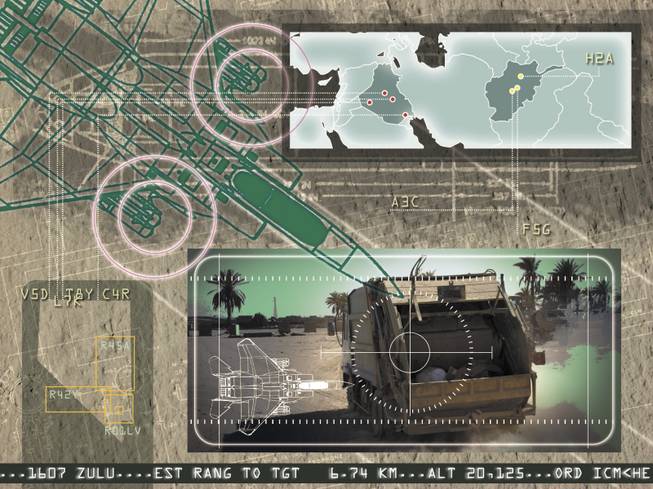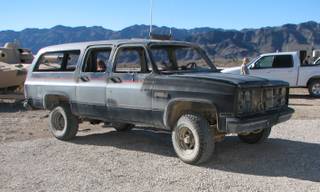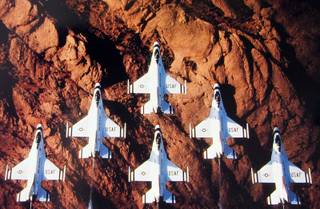Sunday, March 1, 2009 | 2 a.m.
Sun Archives
- Nellis in race for best Air Force base (2-10-2009)
- Air Force: Dogfighters out, warthogs in (1-29-2009)
- Six Questions: Maj. Paul Kirmis, U.S. Air Force pilot (11-19-2008)
- Where the fighter pilot calls home (5-15-2008)
- Nellis an important part of Air Force history (4-19-1997)
Beyond the Sun
Ponder if you will, an SAT question with a combat twist:
A truck carrying top-level insurgents flees west at 70 mph on a dusty road in Iraq. At the same time an F-15 carrying a bomb flies east at 1,600 mph, 20,000 feet above. When does the truck get blown to smithereens?
For a time in Iraq the answer was: rarely.
The fighter pilots just couldn’t do what was being asked of them. Namely, to hit a fast-moving ground target.
Enter Nellis Air Force Base.
With the desert north of Las Vegas serving as Iraq and Afghanistan, Nellis solves almost all of that kind of air-related problem faced by U.S. forces in the Middle East. The 53rd Wing is the Air Force’s go-to problem solver.
The military calls the problems “urgent operating needs,” urgent being the operative word. When one comes up, Nellis’ 53rd Wing units — which specialize in testing new systems and developing the tactics to use them — drop everything and fix it, fast. In most cases a new technology, weapon or tactic is sent back to the field for use in combat within six months.
That quick response is integral to the wars in Iraq and Afghanistan. In prolonged fights, both sides continually adapt, but an insurgency adds another dimension to changing battle tactics, according to Jeff White, a defense fellow at The Washington Institute. Rather than just one enemy that has a single way of doing business, an insurgency is made up of many groups with varying tactics, so the level of innovation is greater.
In the case of fleeting targets, the insurgents had learned they couldn’t hide, so they started holding meetings in speeding cars.
Ground forces could chase them, but it’s risky. Instead, commanders turned to airstrikes.
That tactic might seem obvious and effective, but besides the Air Force’s A-10, which there are not enough of to rely on, none of the fighters could accomplish the mission.
So as airstrikes got called in and the enemy escaped, the question was thrown up the chain of command: Why can’t you take out those targets?
And an urgent operating need was born.
The problem was a combination of pilots lacking the training to strike fast-moving targets and the aircraft lacking an appropriate weapons system for that task, according to Lt. Col. Dan Holmes, deputy commander of the 53rd Test and Evaluation Group.
Here’s how Nellis resolved the issue.
First up, it had to recreate the situation.
On the base’s range, about an hour’s drive north of Las Vegas, an unpaved, 3-mile-long, 250-foot-wide track was carved into a dry lake bed. The plan called for vehicles to race down it for elaborate target practice.
Fortuitously, the Air Force knew of a company on the East Coast that rigged six old vehicles to be remotely operated with cameras. The Air Force took all six.
The trucks were little more than metal shells, with no windshield, windows or seats. One lipstick-sized camera pointed at the speedometer. The other looked forward to provide a view for the remote operator a few miles away.
With the track set up, the next step was testing the Air Force’s various weapons.
Some are designed for fast-moving targets but aren’t an option in urban areas because the kill radius risks collateral damage, including civilian deaths, Holmes said.
But none of the other bombs were effective enough, so Nellis looked to outside sources.
A good prospect seemed to be a Navy missile that hadn’t been used for this kind of mission. And Boeing was upgrading a bomb to have laser capabilities that looked promising for striking moving targets. The Air Force bought all 12 of the Boeing bombs to test along with the Navy’s missiles.
Success.
Simply put, the two weapons can track a target moving at, say, 70 mph, and both seemed to solve the Air Force’s problem in Iraq.
Because commanders in Iraq would have preferred the capability yesterday, there wasn’t time to make the systems perfect. The Air Force had to trick the jets’ software into accepting the new weapons.
And the answer to that SAT question now? The enemy vehicle is destroyed about 25 seconds after the bomb is released. (Essentially, if insurgents hear the roar of the jets overhead, it’s too late.)
That particular Nellis assignment was about the ability to kill, but sometimes the need is to shorten the minutes between identifying a threat and destroying it. The military calls this the kill chain.
For example, when calling in an airstrike, it may be difficult to describe a target — say, someone hiding behind a tall rock on a ridgeline — to the pilot.
To deal with this, Nellis developed a system in which streaming video from the pilot’s point of view is transmitted to a ground spotter who can give the pilot more specific directions.
Nellis also develops new tactics and techniques for using existing equipment in different ways.
For instance, one urgent need was to provide a security escort for convoys, a nontraditional task for Air Force pilots. Nellis developed a tactic — the details can’t be published — to use the jets’ high-resolution video to scan ahead of convoys for threats.
The 53rd Wing is now trying to figure out how to add equipment to helicopters that are not only flying 6,000 pounds heavier than the optimal weight but at the maximum weight.
“We’ve maxed out the aircraft, so everything (added) has a cost,” said Maj. Martin Crawford, a helicopter pilot who has deployed six times for a total of almost two years in Afghanistan and who now is a test pilot at Nellis.
Pilots deployed to Afghanistan know that all too well.
The country’s terrain, which ranges from sea level to 20,000 feet, makes it “the most difficult environment we fly in,” Crawford said. “It’s ugly.”
To fly in high elevations in the mountains, pilots have to lighten the helicopters by removing armor.
“It’s risk versus reward. You’re more susceptible, but if you don’t take the armor off you can’t pick people up,” Crawford said. “I’ve never flown with it in.”
The 53rd Wing is testing armor made of a plastic composite light enough to allow the helicopter to fly in high altitudes.
(The mountains have caused issues for fighter jets as well, such as blocking the ability for an operations center or special ops squad on the ground to pass intelligence along to the pilots. To solve that urgent need, Nellis put satellite communications in each of the fighters).
Then there’s the desert sand. One of the most dangerous tasks a helicopter pilot faces is landing in what’s known as brownout, in which blowing sand obliterates not only the horizon but the landing spot itself.
The urgent need was to make those approaches safer. The solution was basically a system that allows the helicopter to hover not far above the ground without a possibly disoriented pilot needing to handle the controls.
And the fate of that fast-moving target practice?
It’s staying around for ongoing training because of popular demand.




Join the Discussion:
Check this out for a full explanation of our conversion to the LiveFyre commenting system and instructions on how to sign up for an account.
Full comments policy